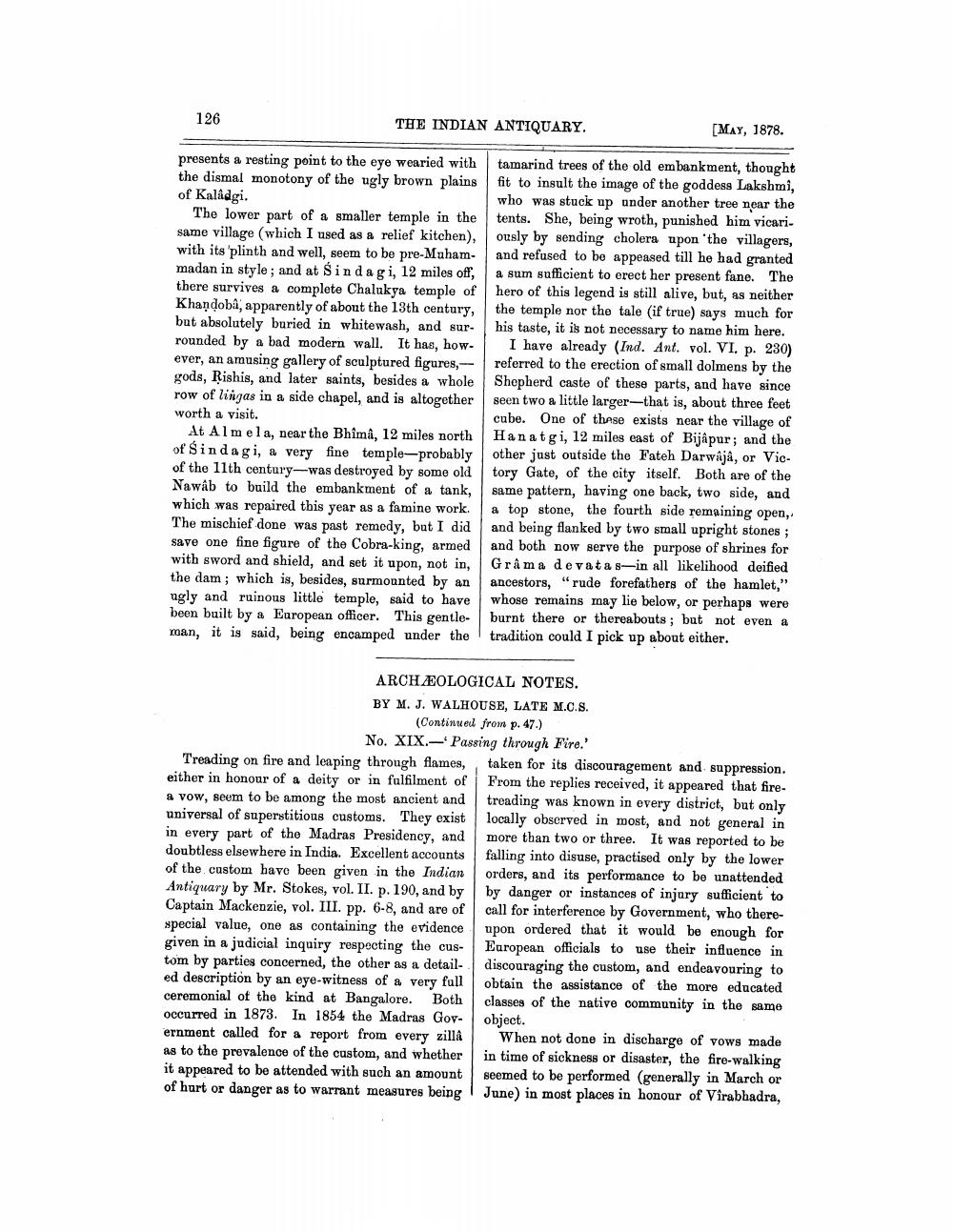________________
126
THE INDIAN ANTIQUARY.
presents a resting point to the eye wearied with the dismal monotony of the ugly brown plains of Kalâdgi.
The lower part of a smaller temple in the same village (which I used as a relief kitchen), with its 'plinth and well, seem to be pre-Muhammadan in style; and at Sindagi, 12 miles off, there survives a complete Chalukya temple of Khandoba, apparently of about the 13th century, but absolutely buried in whitewash, and surrounded by a bad modern wall. It has, however, an amusing gallery of sculptured figures, gods, Rishis, and later saints, besides a whole row of lingas in a side chapel, and is altogether worth a visit.
At Almela, near the Bhîmâ, 12 miles north of Sindagi, a very fine temple-probably of the 11th century-was destroyed by some old Nawab to build the embankment of a tank, which was repaired this year as a famine work. The mischief done was past remedy, but I did save one fine figure of the Cobra-king, armed with sword and shield, and set it upon, not in, the dam; which is, besides, surmounted by an ugly and ruinous little temple, said to have been built by a European officer. This gentleman, it is said, being encamped under the
[MAY, 1878.
tamarind trees of the old embankment, thought fit to insult the image of the goddess Lakshmi, who was stuck up under another tree near the tents. She, being wroth, punished him vicariously by sending cholera upon the villagers, and refused to be appeased till he had granted a sum sufficient to erect her present fane. The hero of this legend is still alive, but, as neither the temple nor the tale (if true) says much for his taste, it is not necessary to name him here.
I have already (Ind. Ant. vol. VI. p. 230) referred to the erection of small dolmens by the Shepherd caste of these parts, and have since seen two a little larger-that is, about three feet cube. One of these exists near the village of Hanat gi, 12 miles east of Bijapur; and the other just outside the Fateh Darwajâ, or Victory Gate, of the city itself. Both are of the same pattern, having one back, two side, and a top stone, the fourth side remaining open,. and being flanked by two small upright stones; and both now serve the purpose of shrines for Grâma devata s-in all likelihood deified ancestors, "rude forefathers of the hamlet," whose remains may lie below, or perhaps we were burnt there or thereabouts; but not even a tradition could I pick up about either.
ARCHEOLOGICAL NOTES.
BY M. J. WALHOUSE, LATE M.C.S. (Continued from p. 47.) No. XIX. Passing through Fire.'
Treading on fire and leaping through flames, either in honour of a deity or in fulfilment of a vow, seem to be among the most ancient and universal of superstitious customs. They exist in every part of the Madras Presidency, and doubtless elsewhere in India. Excellent accounts of the custom have been given in the Indian Antiquary by Mr. Stokes, vol. II. p. 190, and by Captain Mackenzie, vol. III. pp. 6-8, and are of special value, one as containing the evidence given in a judicial inquiry respecting the custom by parties concerned, the other as a detailed description by an eye-witness of a very full ceremonial of the kind at Bangalore. Both occurred in 1873. In 1854 the Madras Government called for a report from every zillâ as to the prevalence of the custom, and whether it appeared to be attended with such an amount of hurt or danger as to warrant measures being
taken for its discouragement and suppression. From the replies received, it appeared that firetreading was known in every district, but only locally observed in most, and not general in more than two or three. It was reported to be falling into disuse, practised only by the lower orders, and its performance to be unattended by danger or instances of injury sufficient to call for interference by Government, who thereupon ordered that it would be enough for European officials to use their influence in discouraging the custom, and endeavouring to obtain the assistance of the more educated classes of the native community in the same object.
When not done in discharge of vows made in time of sickness or disaster, the fire-walking seemed to be performed (generally in March or June) in most places in honour of Virabhadra,




